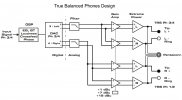Thank you Trell! We have a very similar setup it seems. It's much cheaper indeed. I will most definitely keep this option in mind.
I've also an RME Fireface UCX II audio interface that I connect to the ADI-2 DAC FS using optical for monitoring, so the analog inputs of the ADI-2 Pro is of no use for me as it's not a mic preamp. Nor do I need the feature of two headphone outputs working at the same time with their own EQ and volume control that the ADI-2 Pro has.
As the price jumps from ADI-2 DAC FS to ADI-2 Pro to ADI-2/4 Pro are quite substantial (at least for me) it's worth having a look at one needs. My setup with UCX II and ADI-2 DAC FS is similar price as the ADI-2/4 Pro, but for my needs the current combo is useful for what I want.
My other desktop Genelec 2.1 uses the MOTU M2 instead.
Using AES input on your Genelec may cause the ISS (auto standby) not working correctly due to digital bit clock sensed from the digital input. This is the case when using headphones, say. That might or might not be a an issue for you. For me it is.
Intelligent Signal Sensing (ISS™) for power consumption reduction in stand-by mode.

www.genelec.com


